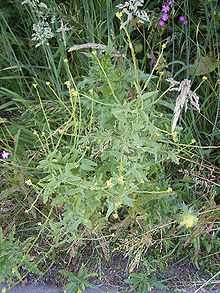Sisymbrium officinale
| Hedge-mustard | |
|---|---|
 | |
| Scientific classification | |
| Kingdom: | Plantae |
| (unranked): | Angiosperms |
| (unranked): | Eudicots |
| (unranked): | Rosids |
| Order: | Brassicales |
| Family: | Brassicaceae |
| Genus: | Sisymbrium |
| Species: | S. officinale |
| Binomial name | |
| Sisymbrium officinale (L.) Scop. | |
Hedge mustard (Sisymbrium officinale) is a plant in the family Brassicaceae. It is found on roadsides and wasteland, and as a weed of arable land. A native of Europe and North Africa, it is now well-established throughout the world.
It is distinct from the mustard plants which belong to the genus Brassica.
The Hedge-mustard is food for the caterpillars of some Lepidoptera, such as the small white (Pieris rapae).
Uses
In food
This plant is widely cultivated across Europe for its edible leaves and seeds. It is widely used as a condiment in Northern Europe (particularly Denmark, Norway and Germany).
The leaves have a bitter cabbage-like flavour and they are used either in salads or cooked as a pot herb (in cultivar versions). The seeds have been used to make mustard pastes in Europe.[1]
Traditional medicine
The Greeks believed it was an antidote to all poisons.[citation needed] In folk medicine, it was used to soothe sore throats - indeed one name for it is singer's plant. Herbalists use the juice and flowers for bronchitis and stomach ailments, among other uses, and as a revitalizer.[2] In Tibetan medicine it is used to repress the symptoms of food poisoning.[3]
References
- ↑ "Plants for A Future Database - Sisymbrium officinale". Plants for a Future database. Retrieved 2007-05-25.
- ↑ Howard, Michael. Traditional Folk Remedies (Century, 1987), p.153
- ↑ Medical Thangka